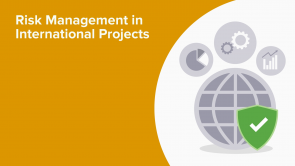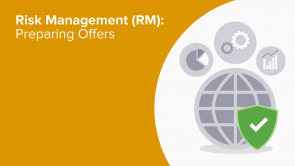Risk Assessment

Über den Vortrag
Der Vortrag „Risk Assessment“ von Simone Hoferer ist Bestandteil des Kurses „Risk Management (RM): Preparing Offers“. Der Vortrag ist dabei in folgende Kapitel unterteilt:
- Introduction & objective
- a) Qualitative risk assessment
- b) Quantitative risk assessment
- c) Over all risk assessment
Quiz zum Vortrag
What is the purpose of the qualitative risk assessment?
- It provides a better insight on the probability of occurrence and the impact on the project of the individual risks & chances.
- It helps to prioritize the identified risks/opportunities for further handling.
- It serves as a basis for calculating the expected costs of damage in case of occurrence.
- Its only purpose is to provide better evaluation of the general overall situation of the project.
Risks with low likelihood and high impact on the project ...
- must be included in the action planning.
- can be neglected since they will hardly ever occur.
- could be included into the action planning if there is enough time and resources available to work on these, too.
- are not relevant for the project.
How do you get a reliable risk assessment?
- Experience and lesson learned
- Interview experts
- Use of statistics
- Intuition, gut feeling
- Internet
The purpose of quantitative risk assessment is ...
- to quantify the potential consequences in costs and work days.
- only worthwhile in large projects. For small projects it is too much effort most of the times.
- to provide better understanding on what to focus on in action planning.
- is a nice mathematical brainteaser to make the project manager feel better.
How do you do a proper evaluation?
- Ask seniors, colleagues or experts.
- Use your team.
- Include aspects as quality and performance or possible effect on customer and market position.
- Compare with other projects.
- Use your gut feeling or intuition.
The overall risk assessment ...
- serves as a basis for the decision for further proceeding (e.g. offer yes/ no?).
- is only for complete documentation.
- is optional but not really advisable.
- is the basis for the decision which team member should take care of the risk management in the project.
An overall risk assessment should be ...
- repeated at the end of the risk management process before finalizing the quote.
- repeated at the end of the qualitative risk assessment.
- repeated at the end of the quantitative risk assessment.
- done at the very beginning of the risk management process before finalizing the quote.
Kundenrezensionen
5,0 von 5 Sternen
| 5 Sterne |
|
5 |
| 4 Sterne |
|
0 |
| 3 Sterne |
|
0 |
| 2 Sterne |
|
0 |
| 1 Stern |
|
0 |
Auszüge aus dem Begleitmaterial
... To learn the methods of quantitative and qualitative risk assessment ...
... in regard of its likelihood and impact on the project in costs and days. c) Overall risk assessment: evaluation of a) and b) ...
... of occurrence of upcoming events and the effect it would cause on the project. To prioritize the identified risks ...
... risk – effect“. Add two columns for your rating ...
... Tropical climate with high humidity, technical equipment not designed for expensive repair, false data, too tight time ...
... risk planning). Categorize the probability and the effect Type: use minimum 3 categories. 5 categories have ...
... this example with 5 categories: 140 probability scale rating. probability in % 5, very high 80 ...
... not acceptable 3, medium delay of (… days), 5 - 10% project duration, exceeding 5 - 10 % (… €), key merits are affected to rather low delay of (… days), < 5% project duration exceeding < 5 % ...
... high humidity, technical equipment not designed for expensive repair, false data too tight time schedule, unforeseen events cannot be compensated, delay and additional costs ...
... assessment - interview experts - use statistics (if available) - intuition, gut feeling - ask information ...
... dealing with numbers, it´s not science or mathematics. Don´t just trust the numbers! It´s an estimation, ...
... the degree of risk for each position. To set priorities for which action ...
... of risk matrix: Take your table „cause–risk ...
... Risk matrix – transfer. For each individual risk/ ...
... let them place their ratings simultaneously into the matrix. Afterwards you may discuss result. Best practice is to ...
... all members of your team and senior colleagues from other departments. Discuss the risks which have been rated ...
... temperatures which was known to the engineers. If the start would have been put off for warmer temperatures, the disaster would have been avoidable. ...
... Always include risks with high scopes of consequences into your action measures. Prevent all risks ...
... on and put the most effort into during action planning. Only worthwhile in large projects. For ...
... and add columns as shown: 157 no risk P in %, cost in EUR, value at risk in EUR ...
... performance or possible effect on customer an market position Compare with other projects => ...
... In order to check on the key issues it may worth while to examine „worst case <> best case“. Approach same as before, ...
... be put into action planning - shows the total risk of the project - sheds light on the ...
... - approach: „zoom-out“ and get a good overview over the overall picture. Change ...
... they easy to get under control or preventable? Are they rather fears or real risks? Which questions didn´t we ask? How ...
... Overall risk assessment: Repeat at the end of ...




